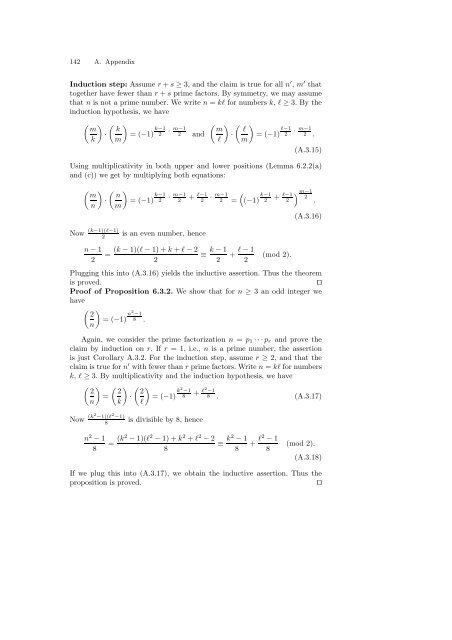Dietzfelbinger M. Primality testing in polynomial time ... - tiera.ru
Dietzfelbinger M. Primality testing in polynomial time ... - tiera.ru
Dietzfelbinger M. Primality testing in polynomial time ... - tiera.ru
You also want an ePaper? Increase the reach of your titles
YUMPU automatically turns print PDFs into web optimized ePapers that Google loves.
142 A. Appendix<br />
Induction step: Assume r + s ≥ 3, and the claim is t<strong>ru</strong>e for all n ′ , m ′ that<br />
together have fewer than r + s prime factors. By symmetry, we may assume<br />
that n is not a prime number. We write n = kℓ for numbers k, ℓ ≥ 3. By the<br />
<strong>in</strong>duction hypothesis, we have<br />
� � � �<br />
m k<br />
· =(−1)<br />
k m<br />
k−1<br />
2 · m−1<br />
2 and<br />
� � � �<br />
m ℓ<br />
· =(−1)<br />
ℓ m<br />
ℓ−1<br />
2 · m−1<br />
2 .<br />
(A.3.15)<br />
Us<strong>in</strong>g multiplicativity <strong>in</strong> both upper and lower positions (Lemma 6.2.2(a)<br />
and (c)) we get by multiply<strong>in</strong>g both equations:<br />
� � � �<br />
m n<br />
· =(−1)<br />
n m<br />
k−1<br />
2 · m−1 ℓ−1<br />
2 + 2 · m−1 �<br />
2 = (−1) k−1<br />
2<br />
Now (k−1)(ℓ−1)<br />
2<br />
n − 1<br />
2<br />
is an even number, hence<br />
= (k − 1)(ℓ − 1) + k + ℓ − 2<br />
2<br />
≡<br />
k − 1<br />
2<br />
+ ℓ − 1<br />
2<br />
+ ℓ−1<br />
2<br />
(mod 2).<br />
� m−1<br />
2<br />
.<br />
(A.3.16)<br />
Plugg<strong>in</strong>g this <strong>in</strong>to (A.3.16) yields the <strong>in</strong>ductive assertion. Thus the theorem<br />
is proved. ⊓⊔<br />
Proof of Proposition 6.3.2. We show that for n ≥ 3anodd<strong>in</strong>tegerwe<br />
have<br />
� �<br />
2<br />
n<br />
=(−1) n2 −1<br />
8 .<br />
Aga<strong>in</strong>, we consider the prime factorization n = p1 ···pr and prove the<br />
claim by <strong>in</strong>duction on r. Ifr = 1, i.e., n is a prime number, the assertion<br />
is just Corollary A.3.2. For the <strong>in</strong>duction step, assume r ≥ 2, and that the<br />
claim is t<strong>ru</strong>e for n ′ with fewer than r prime factors. Write n = kℓ for numbers<br />
k, ℓ ≥ 3. By multiplicativity and the <strong>in</strong>duction hypothesis, we have<br />
� �<br />
2<br />
n<br />
=<br />
� 2<br />
k<br />
Now (k2 −1)(ℓ 2 −1)<br />
8<br />
n 2 − 1<br />
8<br />
�<br />
·<br />
� 2<br />
ℓ<br />
�<br />
=(−1) k2−1 8<br />
is divisible by 8, hence<br />
= (k2 − 1)(ℓ 2 − 1) + k 2 + ℓ 2 − 2<br />
8<br />
+ ℓ2 −1<br />
8 . (A.3.17)<br />
≡ k2 − 1<br />
8 + ℓ2 − 1<br />
8<br />
(mod 2).<br />
(A.3.18)<br />
If we plug this <strong>in</strong>to (A.3.17), we obta<strong>in</strong> the <strong>in</strong>ductive assertion. Thus the<br />
proposition is proved. ⊓⊔












